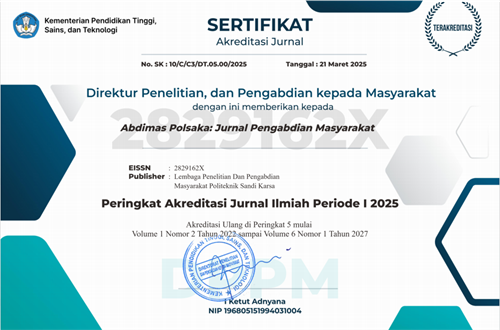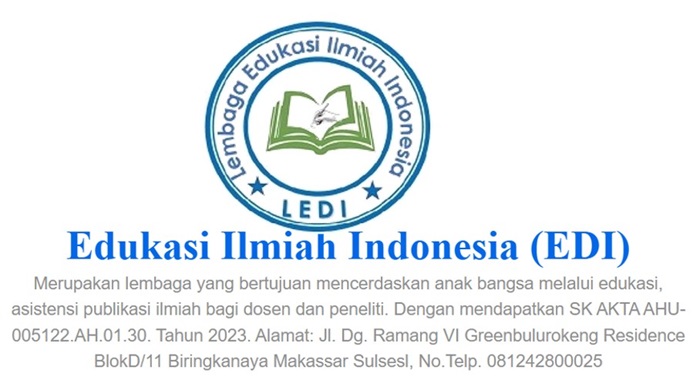Empowerment of brides-to-be in an effort to prevent stunting events early through balanced nutrition
DOI:
https://doi.org/10.35816/abdimaspolsaka.v4i2.110Keywords:
Balanced Nutrition, Community Empowerment, Prospective Couples, Stunting PreventionAbstract
Stunting, a condition of impaired growth and development among children under five caused by chronic malnutrition in the first 1,000 days of life, remains a significant public health issue in Indonesia. Early prevention efforts are essential, particularly among women of reproductive age and prospective brides and grooms, who are critical in ensuring optimal maternal and child health. This community service program was conducted at Puskesmas Sekaran, Semarang, to empower prospective couples through balanced nutrition education to reduce the risk of stunting. The program adopted a participatory approach involving health workers, village authorities, and the Office of Religious Affairs. Activities included baseline assessments of chronic energy deficiency (CED) and anemia, development of educational media (booklets, leaflets, and banners), pre-marital nutrition classes, and intensive student mentoring. The intervention reached 25 participants across five villages, with activities delivered interactively through presentations, discussions, and Q&A sessions addressing scientific facts and common myths about nutrition. Pre- and post-tests were used to evaluate changes in knowledge, showing significant improvements: average pre-test scores increased from 89/100 to 95/100, with 92% of participants demonstrating improved knowledge and 76% achieving perfect post-test scores. These findings highlight that nutrition education, supported by user-friendly media, effectively enhances knowledge and awareness regarding balanced nutrition among prospective brides and grooms. The program demonstrates that empowering couples before marriage contributes to healthier pregnancy preparation, reduces risks of CED and anemia, and ultimately supports the national goal of lowering stunting prevalence.
Downloads
References
F. Luthfia, T. Titania, T. Hidayat, and M. H. Bharoto, “Stunting: Problems And Prevention Efforts By Stakeholders,” Int. J. Soc. Serv. Res., vol. 5, no. 3, pp. 328–336, Mar. 2025, DOI: https://doi.org/10.46799/ijssr.v5i3.1202
A. Soliman et al., “Early and long-term consequences of nutritional stunting: From childhood to adulthood,” Acta Bio Medica Atenei Parm., vol. 92, no. 1, p. e2021168, 2021, doi: https://dx.doi.org/10.23750/abm.v92i1.11346.
C. Scheffler and M. Hermanussen, “Stunting is the natural condition of human height,” Am. J. Hum. Biol., vol. 34, no. 5, p. e23693, May 2022, DOI: https://doi.org/10.1002/ajhb.23693
W. Meikawati, D. P. K. Rahayu, and I. A. Purwanti, “Berat badan lahir rendah dan anemia ibu sebagai prediktor stunting pada anak usia 12–24 bulan di wilayah Puskesmas Genuk Kota Semarang,” Media Gizi Mikro Indones., vol. 13, no. 1, pp. 37–50, 2021, DOI: https://doi.org/10.22435/mgmi.v13i1.5207
D. Simbolon and F. Riastuti, “Adolescent Marriages and Risk Of Stunting in Children Under Five Years in Indonesia,” Indones. J. Public Heal., vol. 19, no. 2, p. 276, 2024, DOI: https://doi.org/10.20473/ijph.v19i2.2024.276-288
R. Cholidah, A. Danianto, R. D. Ayunda, and D. Rahmadhona, “The History of Anemia in Pregnancy with Stunting Incidents in Toddlers at Nipah Community Health Center, Malaka, North Lombok Regency,” J. Penelit. Pendidik. IPA, vol. 9, no. 12, pp. 12226–12231, 2023, DOI: https://doi.org/10.29303/jppipa.v9i12.4946
S. Prabu Aji, S. Sumarmi, R. Millati, Y. Tri Wijayanti, and I. Aris Tyarini, “Increasing Community Nutrition Awareness through Balanced Nutrition Education Program,” Abdimas Polsaka, vol. 3, no. 1, pp. 33–39, Feb. 2024, DOI: https://doi.org/10.35816/abdimaspolsaka.v3i1.65
U. Marbun, N. Sari, I. Irnawati, L. Sari, and D. Dahniar, “The effectiveness of reproductive midwifery care with the flour albus approach: A Case Study of handling vaginal discharge in women of childbearing age,” J. Ilm. Kesehat. Sandi Husada, vol. 13, no. 2 SE-Book Review, Dec. 2024, DOI: https://doi.org/10.35816/jiskh.v13i2.1218
M. Wulansari et al., “Healthy adolescents free of anemia in iyok village, north bolaang mongondow regency,” Abdimas Polsaka, vol. 4, no. 1, pp. 43–39, Mar. 2025, DOI: https://doi.org/10.35816/abdimaspolsaka.v4i1.89
N. M. Saville et al., “Effects of preconception nutrition interventions on pregnancy and birth outcomes in South Asia: a systematic review,” Lancet Reg. Heal. - Southeast Asia, vol. 36, p. 100580, 2025, DOI: https://doi.org/10.1016/j.lansea.2025.100580
S.-H. Kim, S.-Y. Jung, J.-H. Park, and J. C. De Gagne, “Internet-Based Interventions for Preventing Premature Birth in Preconceptional Women of Childbearing Age: Systematic Review,” J. Med. Internet Res., vol. 27, 2025, DOI: https://doi.org/10.2196/60690
S. Liu, G. Augustin, N. Ning, and E. Ota, “Preconception educational interventions for women, present landscape, gaps, and future directions: A scoping review,” Int. J. Nurs. Stud., vol. 169, p. 105134, 2025, DOI: https://doi.org/10.1016/j.ijnurstu.2025.105134
R. Chowdhury et al., “Impact of an Integrated Intervention Package During Preconception, Pregnancy, and Early Childhood on the Gut Microbiome at Six Months of Age: Findings from the Women and Infants Integrated Growth Study (WINGS) Randomized Controlled Trial,” J. Nutr., vol. 155, no. 7, pp. 2355–2366, 2025, DOI: https://doi.org/10.1016/j.tjnut.2025.04.016
M. A. McCabe et al., “Pilot study for a preconception educational intervention for people with mobility disabilities,” Sex. Reprod. Healthc., vol. 44, p. 101101, 2025, DOI: https://doi.org/10.1016/j.srhc.2025.101101
A. D. Balami, S. M. Said, N. A. M. Zulkefli, B. Norsa’adah, and B. Audu, “Improving malaria preventive practices and pregnancy outcomes through a health education intervention: A randomized controlled trial,” Malar. J., vol. 20, no. 1, p. 55, Jan. 2021, DOI: https://doi.org/10.1186/s12936-021-03586-5
S. S. Salam et al., “Impact of a school‐based nutrition educational intervention on knowledge related to iron deficiency anaemia in rural Karnataka, India: A mixed methods pre–post interventional study,” BJOG An Int. J. Obstet. Gynaecol., vol. 130, no. S3, pp. 113–123, Nov. 2023, DOI: https://doi.org/10.1111/1471-0528.17619
S. Zakiyyah Putri, Sitti Maryam Bachtiar, and S. Suprapto, “A Descriptive Case Series on Combined Education, Breast Care, and Oxytocin Massage for Lactation Support in Indonesia,” J. Public Heal. Sci., vol. 4, no. 02 SE-Research Articles, pp. 165–179, Jul. 2025, Doi: https://doi.org/10.56741/IISTR.jphs.001030.
R. Wulandari and A. Syafiq, “The effect of nutrition education on prospective bride in pregnancy nutrition preparation to prevent the risk of stunting: study literature review,” Muhammadiyah Int. Public Heal. Med. Proceeding, vol. 3, no. 1, pp. 79–93, 2023, DOI: https://doi.org/10.61811/miphmp.v3i1.386
R. Raflizar, M. Damris, A. Johari, and H. Herlambang, “Community-Based Educational Approaches to Stunting Prevention,” Heal. Educ. Heal. Promot., vol. 13, no. 1, pp. 21–30, 2025, Doi: https://dx.doi.org/10.58209/hehp.13.1.21.
N. Hasanica, A. Ramic-Catak, A. Mujezinovic, S. Begagic, K. Galijasevic, and M. Oruc, “The effectiveness of leaflets and posters as a health education method,” Mater. Sociomed., vol. 32, no. 2, p. 135, 2020, DOI: https://doi.org/10.5455/msm.2020.32.135-139

Additional Files
Published
How to Cite
Issue
Section
License
Copyright (c) 2025 Mardiana Mardiana, Tesa Rafhani, Farida Dwi Rokhmah, Maria Ulfa, Aryanti Setyaningsih, Palgunadi Palgunadi, Alfi Nurul Khidmah, Jovita Salsabila, Raditya Ardiyansyah

This work is licensed under a Creative Commons Attribution 4.0 International License.




















